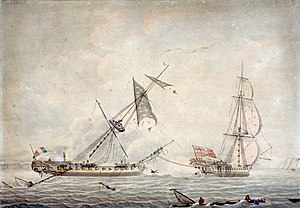 HMS Blanche tows the captured Pique into port, depicted by Robert Dodd
| |
| History | |
|---|---|
| Name | Pique |
| Builder | Rochefort |
| Laid down | January 1783 |
| Launched | 2 December 1785 |
| Completed | By 1786 |
| Renamed |
|
| Captured | 6 January 1795, by the Royal Navy |
| Name | HMS Pique |
| Acquired | 1795 |
| Fate | Wrecked and burned 30 June 1798 |
| General characteristics [1][2] | |
| Class and type | Galathée class frigate, later 38-gun fifth rate frigate |
| Displacement | 1,150 tons (French) |
| Tons burthen | 906 21⁄94 (bm) |
| Length |
|
| Beam | 37 ft 9+1⁄4 in (11.5 m) |
| Depth of hold | 11 ft 8 in (3.6 m) |
| Propulsion | Sails |
| Sail plan | Full-rigged ship |
| Complement |
|
| Armament |
|
HMS Pique was a 38-gun fifth rate frigate of the Royal Navy. She had formerly served with the French Navy, initially as the Fleur-de-Lys, and later as the Pique. HMS Blanche captured her in 1795 in a battle that left the Blanche's commander, Captain Robert Faulknor, dead. HMS Pique was taken into service under her only British captain, David Milne, but served for just three years with the Royal Navy before being wrecked in an engagement with the French ship Seine in 1798. The Seine had been spotted heading for a French port and Pique and another British ship gave chase. All three ships ran aground after a long and hard-fought pursuit. The arrival of a third British ship ended French resistance, but while the Seine and Jason were both refloated, attempts to save Pique failed; she bilged and had to be abandoned.
